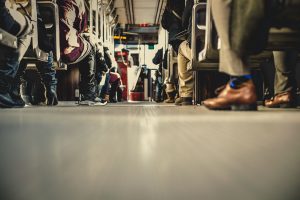Earthquakes are literally impossible to predict, which is why it’s so important to prepare ahead of time. That way, whenever one happens, you are ready and, more importantly, you’re safe. We posted recently about What To Do In An Earthquake When You’re Not at Home, but what happens if an earthquake occurs while you’re parking your car or taking the dog for a walk – how exactly do you prepare for that?
The first step to preparation is education, and we’ve put together some unique scenarios that you might find yourself in as an earthquake happens, and the ways that you can stay safe in each of them.
In the Bathroom
 Whether you’re taking a shower or standing at the sink, the bathroom isn’t a bad place to be in an earthquake! If you feel things shaking, it’s best to stay put and practice your Drop, Cover, and Hold On – in fact, you’ll probably want to stay in the shower stall or tub if you’re mid-lather to avoid falling objects. To prepare ahead of time, be sure to secure any heavier objects that might come loose in an earthquake, or think about relocating them to another part of your home.
Whether you’re taking a shower or standing at the sink, the bathroom isn’t a bad place to be in an earthquake! If you feel things shaking, it’s best to stay put and practice your Drop, Cover, and Hold On – in fact, you’ll probably want to stay in the shower stall or tub if you’re mid-lather to avoid falling objects. To prepare ahead of time, be sure to secure any heavier objects that might come loose in an earthquake, or think about relocating them to another part of your home.
Walking Down the Street
This is potentially the most dangerous situation in an earthquake as you’re more exposed to falling debris or breaking glass. While Drop, Cover, and Hold On is the most important thing to remember wherever you are, this is one of the occasions where it might be safer to step into a building doorway first to provide you with immediate shelter. Ideally you’ll want a doorway that’s not surrounded by glass, you should get low to the ground to prevent losing your balance and falling, and hold on to something secure, if possible, to wait for the shaking to stop. Once it does, it is especially important to wait at least 60 seconds before moving back out into the street, as there is a much higher chance that debris will continue to fall as well as the risk of downed power lines or fallen trees.
On the Bus
 If your daily commute includes the bus and an earthquake hits, your driver will pull over as soon as it’s safe to do so. Once the bus comes to a standstill, it’s safer to remain inside rather than getting out onto the street so that you can avoid falling debris, downed power lines, and even emergency vehicles racing to get to those that need them. Given the open space available on a bus, you should stay low (drop), cover your head and neck with your arms, and hold on to any of the seats or support poles around you, to ensure that you don’t injure yourself or others around you if the ground (and bus) continues to shake.
If your daily commute includes the bus and an earthquake hits, your driver will pull over as soon as it’s safe to do so. Once the bus comes to a standstill, it’s safer to remain inside rather than getting out onto the street so that you can avoid falling debris, downed power lines, and even emergency vehicles racing to get to those that need them. Given the open space available on a bus, you should stay low (drop), cover your head and neck with your arms, and hold on to any of the seats or support poles around you, to ensure that you don’t injure yourself or others around you if the ground (and bus) continues to shake.
Parking Garage
Whether you’re in an underground parking lot or a regular, above-ground one, a parking garage can provide you with some significant shelter in an earthquake, but you will still want to protect yourself. If you’re not in or close to your car, apply the same principles to this scenario as you would in a building or space that doesn’t have a table or similar structure for you to use for coverage – get close to an inside wall (avoid any windows or wall spaces where possible) or pillar, drop to the ground, and cover your head and neck with your arms. If you’re in or near your car, this is the best place for you to stay – the car’s roof will act as your shelter and you’re already sitting down which will help you stay steady. Turn the radio on to stay up to date with emergency information too, and don’t move from your vehicle until well after the shaking stops.
You might also want to check out our other article, How to Survive 72 Hours In Your Vehicle, for some additional tips on what to do if you’re in your car during a disaster like an earthquake.
Public Venue
 If you’re at an art gallery, mall, or special event, and an earthquake hits, Drop, Cover and Hold On is still your best bet. If you can get under something, do so; if not, use the same principles we mentioned before and find a solid inner wall to shelter next to. Do your best to stay as calm as possible and listen carefully to any instructions given by event organizers or staff, so that they can direct you to a safe evacuation point as quickly as possible.
If you’re at an art gallery, mall, or special event, and an earthquake hits, Drop, Cover and Hold On is still your best bet. If you can get under something, do so; if not, use the same principles we mentioned before and find a solid inner wall to shelter next to. Do your best to stay as calm as possible and listen carefully to any instructions given by event organizers or staff, so that they can direct you to a safe evacuation point as quickly as possible.
While it’s a challenge to prepare for every possible scenario, keeping the basics top of mind can be your biggest help in an earthquake. Find a safe space to Drop, Cover, and Hold On, stay aware of your surroundings, and always take a few moments to plan your next action before doing anything – when you keep these things in mind, you can prevent injuries to yourself, and those around you, and means you can focus on getting back to your family, home, or designated meeting place as soon as possible.
Terms and Conditions
All content provided on this blog is for informational purposes only. The owner of this blog makes no representations as to the accuracy or completeness of any information on this site or found by following any link on this site. The owner will not be liable for any errors or omissions in this information nor for the availability of this information. The owner will not be liable for any losses, injuries, or damages from the display or use of this information. This policy is subject to change at anytime.

